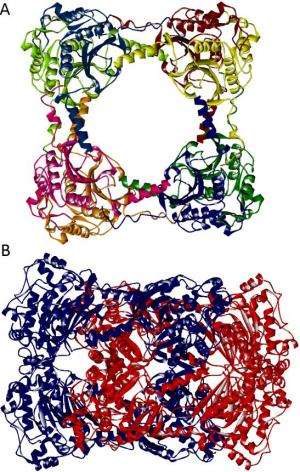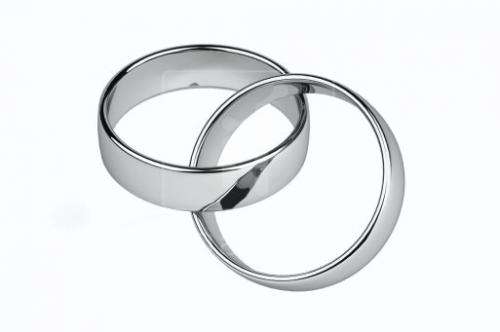Uniquely shaped enzyme amazes chemists

Chemists of Radboud University Nijmegen have found that a uniquely shaped enzyme that has never been seen before in biology is real: two interlocked ring structures, known as catenanes . The results have been published early June in Chemical Communications and were established through a cooperation by the university's chemists and microbiologists.
Microbiologist Mike Jetten is specialized in tracking down new bacteria and archea that perform remarkable chemical reactions. In 2011 he found primal archeon in the mudpots of Italian volcanic solfataras that obtain their energy by converting CS2 into H2S and CO2 with the enzyme CS2hydrolase. Structural analysis revealed that the enzyme is composed of two forms: single ring structures and double ring structures, superposed and riveted together; also called hexadecameric catenanes.
Mysterious rings
The interlocking rings are very special. Their locked protein structure, that is maintained via weak non-covalent interactions, has never been seen before in biology. That is why researchers first had to test whether the catenane structures were an artefact and that they were actually looking at two loose rings accidentally interlocking through each other. Jasmin Mecinovic , chemist at Radboud University Nijmegen, investigated if the 'interlockedness' of the double rings was real. 'By dissolving the enzyme, we could check the ratio of single and double rings in low concentrations. If the double rings indeed were an artefact, you would not expect them in low concentrations because the chance of accidentally superimposed rings is very small there. The ratio proved to be the same in all different solutions, showing that the interlocking rings exist. We checked this with three different chemical techniques: size exclusion chromatography, multi-angle laser light scattering and native mass spectrometric analyes.'

Evolution or coincidence
The three techniques confirmed each other's results and now Mecinovic knows for sure: the interlocking rings are real. His article already attracts a lot of attention: shortly after the online publication in Chemical Communications, the story was selected as a 'hot article' by the journal.
'We have a very special protein assembly in our hands', says Mecinovic. 'In the last decades, chemists extensively investigated artificial small molecule catenanes, but we have initiated the reseach on extremely rare biological catenanes. There are virtually no papers on this subject so there are many fundamental questions that still need to be addressed . Now I want to find out why mother nature chose this form. Maybe it's evolutionary, maybe this shape has advantages over others in catalysis or stability. But it could also be a chemical coincidence. I want to find that out by describing the molecular structure of the double rings even better.'
More information: van Eldijk, M. et al. Evidence that the catenane form of CS2 hydrolase is not an artefact, Chem. Commun., 2013. pubs.rsc.org/en/content/articl … g/2013/cc/c3cc43219j
Journal information: Chemical Communications
Provided by Radboud University Nijmegen




















